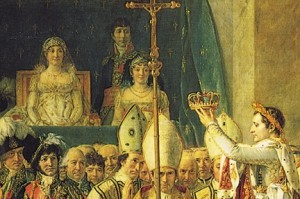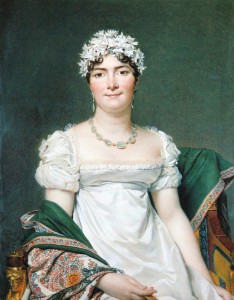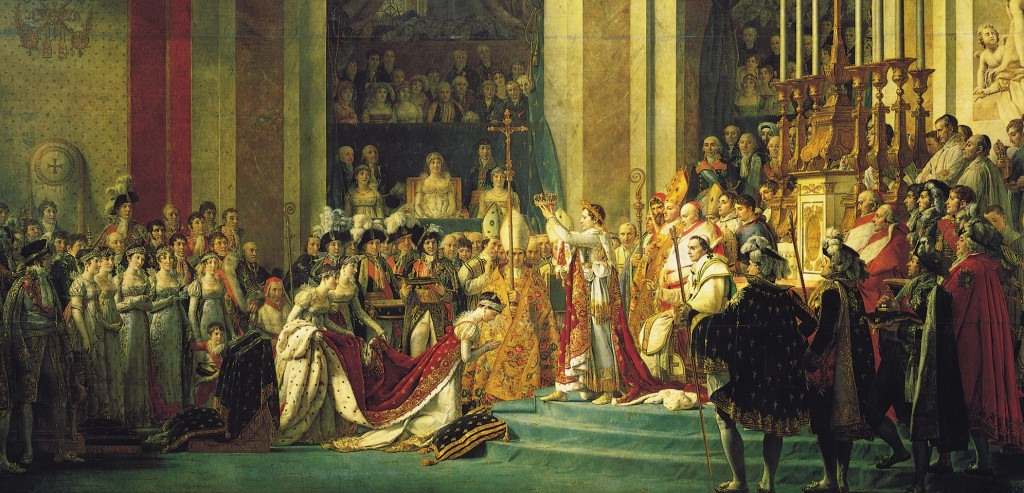When I’m at the Louvre Museum, I seek out Jacques-Louis David’s imposing—if not exactly beautiful—painting of Napoleon and Josephine’s coronation. At thirty-two feet long by twenty feet tall, it’s slightly smaller than Veronese’s The Wedding at Cana, the Louvre’s largest painting.
 The French refer to it as Le Sacre, but its official name is The Consecration of the Emperor Napoleon I and the Coronation of the Empress Josephine in the Cathedral of Notre-Dame de Paris on 2 December 1804. That captures the historical facts since Napoleon crowned himself and Pope Pius VII “consecrated” the act. Then Napoleon performed Josephine’s less holy “coronation.”
The French refer to it as Le Sacre, but its official name is The Consecration of the Emperor Napoleon I and the Coronation of the Empress Josephine in the Cathedral of Notre-Dame de Paris on 2 December 1804. That captures the historical facts since Napoleon crowned himself and Pope Pius VII “consecrated” the act. Then Napoleon performed Josephine’s less holy “coronation.”
There are enough fascinating stories about Le Sacre to fill a book, much less a single blog post. For example, Napoleon’s mother, who was feuding with him at the time, refused to attend the ceremony. Napoleon had David paint her into a prominent position, anyway. Also, originally, the  painting showed Napoleon holding the crown above his own head, but the Emperor had David revise it to the moment of Josephine’s coronation.
painting showed Napoleon holding the crown above his own head, but the Emperor had David revise it to the moment of Josephine’s coronation.
My favorite story actually involves a different painting. In 1810, Le Sacre’s painter, David, produced this charming portrait of the Comtesse Daru, after just a few sittings. He painted the portrait free of charge, unveiling it as a surprise gift for Madame Daru’s husband. It seems the Comte Pierre Daru, a top administrator on Napoleon’s staff, had arranged for the French government to pay the long overdue bill owed to David for the Coronation painting.
The comtesse’s portrait now hangs in New York City in the Frick, one of the world’s great private art museums.


I concur! It is an amazing painting to behold, and the history of it is fascinating. I stopped dead in my tracks the first time I saw it — it’s so huge and so immediately compelling. Thank you for mentioning it.
Pingback: Jacques-Louis David’s Painting of the Coronation of Napoleon toured the United States in 1826 » Finding Napoleon
I saw the painting in 1970—-it was simply amazing and I have forgot it—I purchase a photo of it and still have it today. Fanatic painting.
Yes, it’s almost overwhelming. I love identifying all the historical figures in it. Definitely one of my favorites! Thanks for dropping by my site. Come visit again.
Pingback: Finding Napoleon Bonaparte in Madrid – Part 2 - Finding Napoleon
Pingback: Finding Napoleon: Propaganda from a Plague - Margaret Rodenberg
Is it Davids conceit to change the architecture of Medieval Notre Dame to Neo Classical ?
Or did Napoleon cover the existing with Classical Theatrical Scenery to represent a break from the Bourbon past ?
Am I alone in questioning the setting of the painting? The architecture is neo-classical as opposed to the medieval Gothic of Notre Dame ?
Was this just a conceit of David trying to escape the association of the Bourbon Dynasty ? or did Napoleon design a Classical stage to surround and cover the past ?
I prefer the last idea – a massive Theatre Set in the grand style !
Interesting idea, but I believe you are being mislead by all the decorations and draperies that Napoleon had added to Notre Dame cathedral for his coronation. David certainly took some liberties but it’s definitely Notre Dame. Thanks for the question!
Pingback: Paris Part 3: Art is Exhausting